| 1. Current Research Areas | 2. Antarctic Treaty System: relevant materials | 3. Multilateral Environmental Agreements (MEAs) |
My main interest of study is on the souces of international law and the process of making international law. By taking the examples from Antarctic Treaty system and multilateral environmental agreements (MEAs), I have been studying the legal issues involved in the international legal regime building, especially from the perspectives of sources and “compliance-pull” of international law. Within such context, I have also written on the possible role of NGOs in international law-making and law-implementing processes. After being personally involved in the negotiation and adoption of two “liability” treaties, namely the Antarctic Liability Annex for Environmental Emergencies (2005) and Nagoya-Kuala Lumpur Supplemnetary Protocol on Liability and Redress (2010), it is my immediate academic interest to examine the theoretical aspects of international environmental liability regimes in the 21st century.
On the Antarctic Treaty system, I have spent more than ten years collecting the primary documents of the Antarctic Treaty Consultative Meetings (ATCM) from its first meeting in 1961 to the most recent ones. With the help of the Australian Antarctic Division in Hobart, Tasmania, during my academic leave in 2009-10, I now have a complete set of (almost) all conference documents (Working Papers and Information Papers) from all ATCMs. I believe my office is the only academically-based place on Earth where you can obtain all ATCM documents without prior governmental authorization to access them. Using these primary material, I have been critically analyzing the legitimacy claims of Antarctic Treaty Consultative Parties for their law-making authority over the Antarctic area that is opposable (so as they claim) to the international community as a whole. Recently I have pusblished an article in English on the newly established “liability” Annex to the Madrid Protocol on the environmental protection: “How to Design an International Liability Regime for Public Spaces: the Case of the Antarctic Environment,” in Public Interest Rules of International Law: Towards Effective Implementation (T. Komori & K. Wellens eds., Ashgate, 2009), pp. 347-373. My previous works in Japanese include: Establishment of the Secretariat of the Antarctic Treaty, CRAMRA law-making process and its legitimacy, CCAMLR law-making process and its legitimacy, and the legitimacy of ATCM as law-making forum. From 2004 to 2007, I led a grant-based academic project on the Antarctic Treaty system, gathering not only international lawyers but also scientists conducting Antarctic scientific expeditions and administrative officers overseeing the Antarctic operations in Japan. That porject resulted in: Akiho Shibata ed., Evolution of the Antrarctic Treaty System: An Analysis of its Institutional and Environmental Responses ( Final Report of the Grant-in-Aid for Scentific Research, 2007)(in Japanese).
On the MEAs, since 2001 when I had an opportunity to work at the Japanese Mission to International Organizations in Geneva on environmental portfolio, I was amazed by the intricate international legal issues involved in the process of MEA implemention and operation. My first academic interest went to the Basel Convention on the Control of Transboundary Movement of Hazardous Wastes because I was able to negotiate as a member of the Japanese negotiation and successfully adopt in 2002 the Basel Compliance Mechanism. I was elected a member, and later the rapportuer, of the Compliance Committee for two terms from 2002 to 2006. I have written both in English and Japanese on the negotiation process and the legal significance of the Basel Compliance Mechanism. I also discussed the theoretical and practical relationship between the Basel Compliance mechanism and the Basel dispute settlement procedures in a book co-edited by Professors Shimada, Sugiyama and Hayashi in 2006. Now, the legal issues involving the Ban Amendment, including the interpretation of Article 17 (5) of the Convention, will keep me busy. This issue involves the “evolution” of treaty languages through the interpretative resolutions of the Conference of the Parties (COP) and may become an important precedent for the Vienna Convention on the Law of Treaties, especially Article 31, paragraph 3 (a) and/or (b).
In February 2007, I was asked by the Ministry of Foreign Affairs of Japan to advise them on the negotiation on international rules and procedures on liability and redress under the Cartagena Protocol on Biosafety. Since then, I was able to participate as a member of the Japanese delegation in all negotiating forums (ad hoc working group, then the Group of the Friends of Co-Chairs), that ultimately resulted in a new treaty adopted at COP-MOP5 in October 2010 in Nagoya, Japan. Naturally, my academic interest has broadened to include international liability regimes in general and environmental liability regimes in particular. In the Festschrift Ambassador Chusei Yamada (edited by Professors Murase and Tsuruoka) published in 2011, I have analyzed the “Principles on Allocation of Loss in Case of Transboudary Harm” adopted by the UN ILC in 2006.
Please refer to my CV for exact information relating to my publications.
Professor Shibata’s office at Kobe University has a complete set of (almost) all conference documents (working papers and information papers) from all ATCMs, including Special ATCMs. They are either in hard-copy or in pdf format.
I plan to upload the “List” of documents from all ATCMs so that the interested academia can pinpoint specific documents for their studies, and decided to provide the documents themselves on specific request base (rather than uploading them, which occupy a lot of “space” in my server).
Below is the list of documents relating to (1) Annex VI on Liability arising from Environmental Emergencies adopted in 2005, and (2) the Secretariat of the Antarctic Treaty established in 2003. You can request specific documents by e-mail. I have to charge the necessary fees to prepare (retrieving the correct ones and making photocopies) and send by post or e-mail those documents to you.
Basic Documents on the Antarctic Treaty System
| File Name | |
|---|---|
| antarctic_treaty.pdf | Text of Antarctic Treaty |
| antarctic_map.pdf | Map of Antarctica |
Negotiating Documents on the Annex VI
“Liability arising from Environmental Emergencies” adopted in 2005
Negotiating Documents of the Liability Annex under the Madrid Protocol of the Antarctic Treaty |
||||
|---|---|---|---|---|
Meetings (year and month) |
Document Number |
Document Title |
Submitted by |
|
| ATCM16 (1991.10) | WP33 | Draft outline of the rules and procedures relating to liability for damage to the antarctic environment and dependent and associated ecosystems | Japan | ○ |
| IP55 | Annex on liability and conpensation for antarctic activities | ASOC | ○ | |
| Final report | Final Report of the Meeting | ATS | ||
| ATCM17 (1992.11) | WP8 | Liability for damage arising from activities taking place in the antarctic treaty area (liability annex) | Netherlands | ○ |
| WP11 | Basic elements for an annex on the liability envisaged by the antarctic treaty protcol | Chile | ○ | |
| WP26 | Draft recommendation submitted by chile and the Netherlands | Chile / Netherlands |
○ | |
| WP29 | Draft decision submitted by chile and the Netherlands to be included in the final report of the seventeenth antarctic treaty consultative meeting | Chile / Netherlands |
○ | |
| Final report | Final Report of the Meeting | ATS | ||
| First inter-sessional meeting in Heidelberg (1993.11) | non-paper | Chairman's first offering: annex on environmental liability | Wolfrum | × |
| non-paper | Answers of the States to professor Wolfrum's questionnaire on the annex on environmental liability in antarctica | Wolfrum | × | |
| ATCM18 (1994.4) | WP2 | Liability annex to the protocol on environmental protection to the antarctic treaty | Germany | ○ |
| Final report | Final Report of the Meeting | ATS | ||
| Second inter-sessional meeting in The Hague (1994.11) | ||||
| ATCM19 (1995.5) | WP19 | The need for operational definitions of the terms used in the protocol to the antarctic treaty on the protection of the environment | Chile | ○ |
| WP30 | Liability annex to the protocol on environmental protection to the antarctic treaty | Germany | ○ | |
| WP31.rev1 | Report of the TEWG to the XIX ATCM | Secretariat | ○ | |
| IP24 | Liability annex to the protocol on environmental protection to the antarctic treaty (indludes Answers of the Parties to Wolfrum's Second Offering and Wolfrum's Third Offering) | Germany | ○ | |
| Final report | Final Report of the Meeting | ATS | ||
| Third inter-sessional meeting in Brussels (1995.11) | ||||
| ATCM20 (1996.5) | WP10 | The relatilnship between the protocol on environmental protection to the antarctic treaty and other international agreements of a global regional scope | U.K | ○ |
| WP31 | Liability annex to the protocol on environmental protection to the antarctic treaty | Germany | ○ | |
| IP11 | Letter of the chairman of CCAMLR regarding an alternative text of article 2 of the draft liability annex | CCAMLR | ○ | |
| IP27 | Liability for damage to the antarctic environment | Italy | ○ | |
| IP43 | Annex VI to the protocol on environmental protection to the antarctic treaty Liability for emergency response action | U.S | ○ | |
| IP58 | Financial preparadness and the joint compensaton fund in the annex on environmental liability to the madrid protocol | IUCN | ○ | |
| IP81 | Liability annex to the protocol on environmental protection to the antarctic treaty(includes summary of Brussels meeting and Wofrum's Fifth Offering) | Germany | ○ | |
| IP105 | Annex on environmantal liability chairman's fifth offering ASOC commentary | ASOC | ○ | |
| IP139B | International convention on liability and compensation for damage in connection with the carreiage of hazardous and noxious substans by sea, 1996 | Netherlands | ○ | |
| Final report | Final Report of the Meeting | ATS | ||
| Fourth inter-sessional meeting in Cambridge (1996.10) | ||||
| ATCM21 (1997.5) | WP28 | Liability annex to the protocol on environmental protection to the antarctic treaty | Germany | ○ |
| WP40 | Report of working group 1 to the ATCM XXI | Secretariat | ○ | |
| IP12 | Liability annex to the protocol on environmental protection to the antarctic treaty | Germany | ○ | |
| IP60 | Letter to DR Rudiger Wolflum re Liability | IUCN | ○ | |
| IP63 | Commentary on chairman's seventh offering annex on environmental liability | ASOC | ○ | |
| IP83 | Compulsory insurance under liability regimes | IAATO | ○ | |
| IP92 | Environmental compensationa funds and the antarctic | ASOC | ○ | |
| IP104 | Implicatilns of the current draft liability annex to activities among treaty members | U.S | ○ | |
| IP115 | Background for presentation by DR V.LUKIN-HEAD of the russian antarctic expedition and DR M. MOSKALEVSKY-DEPUTY chairman of russian committee on antarctic research on implications of the draft liability annex to scientific reseach activities in antarctica | Russia | ○ | |
| Final report | Final Report of the Meeting | ATS | ||
| Fifth inter-sessional meeting in Cape Town (1997.11) | ||||
| ATCM22 (1998.4) | WP1 | Liability -report of the group of legal experts | LWG | ○ |
| WP15 | The question of liability -art.16 of the protocol | Germany | ○ | |
| IP126 | Negotiation on an annex or annexes on liability | U.S | ○ | |
| Final report | Final Report of the Meeting | ATS | ||
| ATCM23 (1999.5) | WP10 | Joint and several liability and international collaborative science | New Zealand | ○ |
| WP13 | The question of liability as referred to in article 16 of the protocol | Germany | ○ | |
| WP15 | Principles for an antarctic liability regime | Australia | ○ | |
| WP18 | Liability | New Zealand | ○ | |
| WP21 | Liability | U.K | ○ | |
| WP25 | Operation of the antarctic treaty system | New Zealand | ○ | |
| WP34 | Draft annex on environmental liability to the madrid protocol | Chile | ○ | |
| WP35 | Basic definitions and considerations for the annex on the liability regime | Argentine/ Brazil/Chile/ Ecuador/Peru/ Uruguay |
○ | |
| WP41 | Personal report of the chairman of the liability discussion in working group 1 | New Zealand | ○ | |
| WP42 | Environmental damage | U.K | ○ | |
| IP37 | Environmental protection through the law of international liability | Germany | ○ | |
| IP38 | Factors influencing risk analysis in relation to human activities in antarctica based on German experience with logistics during German antarctic resarch | German | ○ | |
| IP91 | Environmental liability | Germany | ○ | |
| non-paper | Madrid protocol -Liability annex | × | ||
| Final report | Final Report of the Meeting | |||
| ATCM24 (2001.7) | WP6 | Annex on Liability : United States delegation | U.S | ○ |
| WP14 | Response to XXIII ATCM resolution5(1999) | SCAR・COMNAP | ○ | |
| WP17 | Chairman's draft of the annex VI to the protocol on environmental protection to the antarctic treaty "Liability arising from environmental emergencies" | New Zealand | ○ | |
| WP38 | Liability : informal contact group work on "response action","preventive measures","operator and jurisdictional issues"and"dependent and associated ecosystems" | New Zealand | ○ | |
| IP82 | Questions on insurance and limitation of liability under the annex on response measures | Belgium | ○ | |
| Final report | Final Report of the Meeting | ATS | ||
| ATCM25 (2002.9) | WP1 | Contribution to the preparation of a draft annex on liability for pollution, in the framework of the protocol on environmental protection in Antarctica | France | ○ |
| WP2 | Usefulness of an annex VII to the Madrid Protocol regarding the regulation of turist and non-govermental activities in the Antarctic treaty area | France | ○ | |
| WP14 | Chairman's draft | New Zealand | ○ | |
| WP25 | Working paper on "worst case"&"less than worst case" environmental scenarios | COMNAP | ○ | |
| WP27 | Working paper on an assesment of environmental incidents arising from activities in Antarctica | Poland | ○ | |
| IP77 | Liability | ASOC | ○ | |
| IP91 | Introduction to the issue of insurance in annex VI to the protocol on environmental protection (Liability/Response measures) | Chile | ○ | |
| non-paper | Chairman's personal draft | MacKay | × | |
| non-paper | U.S. Delegation article2-definition of operator | U.S | × | |
| non-paper | Contact group article7-actions for compensation | Contact Group | × | |
| non-paper | Contact group article7-actions for compensation(1) | Contact Group | × | |
| non-paper | Small working group-definition of "operator" | Contact Group | × | |
| non-paper | Contact group-scope | Contact Group | × | |
| non-paper | Article1-scope | Contact Group | × | |
| non-paper | Liability session | Contact Group | × | |
| Final report | Final Report of the Meeting | ATS | ||
| ATCM26 (2003.9) | WP9 | "Worst case"&"less than worst case"environmental scenarios | COMNAP | ○ |
| WP33 | Chairman's draft of the annex VI to the protocol on environmental protection to the Antarctic treaty "Liability arising from environmental emergencies" | New Zealand | ○ | |
| Final report | Final Rort of the Meeting | ATS | ||
| ATCM27 (2004.6) | WP6 | Chairman's draft of the annex VI to the protocol on environmental protection to the antarctic treaty "Liability arising from environmental emergencies" | New Zealand | ○ |
| WP34 | EU ATCP | EU | ○ | |
| WP43 | The enquiry procedure of article18 | Spain | ○ | |
| IP85 | Insurance amounts for IAATO turist vessels | IAATO | ○ | |
| IP110 | Revised chairman's draft of annex VI to the protocol on environmental protection to the antarctic treaty "Liability arising from environmental emergencies" | New Zealand | ○ | |
| non-paper | Liability arising from environmental emergencies | Chile | × | |
| Final report | Final Rort of the Meeting | ATS | ||
| New York Infomal Consultations (2005.4) | ||||
| ATCM28 (2005.6) | WP47 | Revised chairman's draft of annex VI to the protocol on environmental protection to the antarctic treaty "Liability arising from environmental emergencies" | New Zealand | ○ |
| WP48 | Outcomes of informal consultations convened by the chairman of the working group on liability in New York from 13 to 15 april 2005 | New Zealand | ○ | |
| WP48 rev.1 | Revised chair's text 8 June 2005 | New Zealand | ○ | |
| WP48 rev.2 | Chairman's revised draft of the annex VI to the protocol on environmental protection to the antarctic treaty "Liability arising from environmental emergencies" and Draft decision to accompany the adoption of the text | New Zealand | ○ | |
| WP48 rev.2 corr.1 | Chairman's revised draft of the annex VI to the protocol on environmental protection to the antarctic treaty "Liability arising from environmental emergencies" and Draft decision to accompany the adoption of the text | New Zealand | ○ | |
| WP48 rev.3 | Draft annex VI to the protocol on environmental protection to the antarctic treaty Liability arising from environmental emergencies as revised and reported back by the drafting committee | New Zealand | ○ | |
| WP49 | Drafting and other proposals presented to the informal consultations convened in New York from 13 to 15 April 2005, which require further consideration | New Zealand | ○ | |
| WP69 | Measure XXX(2005) Annex VI to the protocol on environmental protection to the antarctic treaty Liability arising from environmental emergencies | New Zealand | ○ | |
| WP70 | Decision XXX(2005) Annex VI on liability arising from environmental emergencies to the protocol on environmental protection to the antarctic treaty | New Zealand | ○ | |
| WP72 | Draft resolution XXX(2005) Scientific issues relationg to the implementation of measures of reinstatement of the environment | Netherlands/ Belgium/ Chile/ Finland/ France/ Germany/ Italy/Norway/ South Africa/ Spain/Sweden |
○ | |
| Final report | Final Report of the Meeting | ATS | ||
| ATCM29 (2006.6) | non-paper | Non paper on the implementation of annex VI to the protocol on environmental protection to the antarctic treaty on liability arising from environmental emergencies | × | |
| Final report | Final Report of the Meeting | ATS | ||
Negotiating Documents on the Establishment of
the Secretariat of the Antarctic Treaty, concluded in 2003
| Content. The page and footnote relates to Shibata’s article (2003) |
| Compilation of relevant documents from 1992 to 2001. From Handbook of the Antarctic Treaty System, 9th edition. Article page 123-125, footnotes 33 and 39. |
| Belgian proposal at 18 ATCM (1994). Article page 125, footnote 35. |
| A “protocol” proposal by Australia, Italy and South Africa at 19 ATCM (1995). Article page 125, footnote 40. |
| Non-paper submitted by UK at the first informal meeting in June 2002. Article 131, 147-149, footnote 78. |
| Chair’s report on the first informal meeting held in June 2002. Article page 126-127, footnote 55. |
| Non-paper submitted by Japan and UK at 25 ATCM (2002). Article page 149-150, footnote 143. |
| Chair’s report summarizing the discussion at the 25 ATCM (2002). Article page 127-128, footnote 62. |
| Chair’s report on the second informal meeting held in April 2003. Article page 128-129, footnote 71. |
| Measures and Decisions on the establishment of the Secretariat of the Antarctic Treaty (2003). Article page 121-122, footnote 5. |
Nagoya-Kuala Lumpur Supplementary Protocol on Liability and Redress
to Cartagena Protocol on Biosafety (2007-2011)
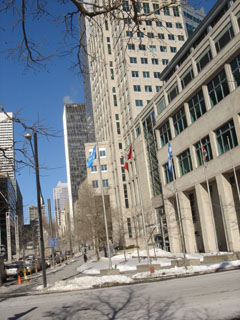
Feb. 2007: ICAO Headquarters, where 3rd meeting of AHWG was held.

March 2008: Conference venue, 5th meeting of AHWG
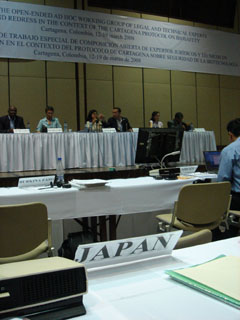
5th meeting of AHWG, Cartagena, Columbia
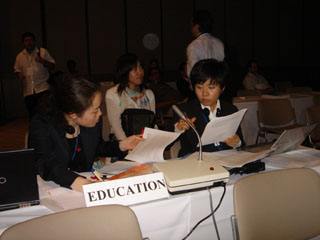
Students from Kobe U. participating in 5th meeting of AHWG, Cartagena
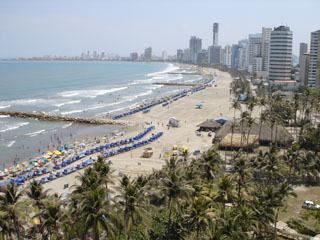
Beaches of Cartagena, no time for swimming
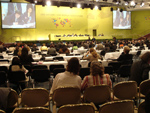
May 2008: COP-MOP4 in Bonn, Germany
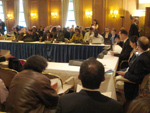
Group of Friends of Co-Chairs during COP-MOP4. Extremely difficult negotiation, with all-night informal negotiations
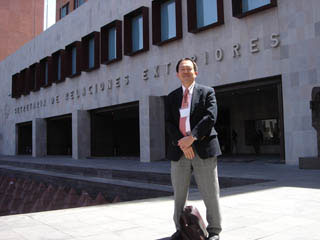
Feb. 2009: Mexican Foreign Ministry, the venue of the First Meeting of GFCC,Mexico City.
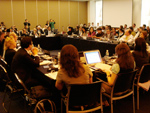
1 GFCC: only one person per delegation can sit around the table.
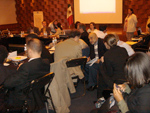
1 GFCC: Malaysia consulting with Swiss

Feb.2010: 2nd meeting of GFCC, Putrajaya, Malaysia

2 GFCC: Kobe University doctoral student assisting the Secretariat
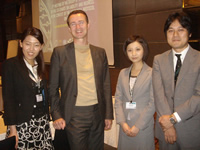
June 2010: 3rd meeting of GFCC, KL, Malaysia. Kobe University students with the Co-Chair.
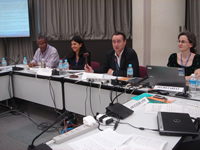
Oct.2010: 4th meeting of GFCC, Nagoya, Japan. Text of the Supplementary Protocol agreed! 2:30 am on Monday the 11th.
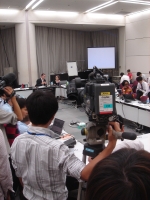
4 GFCC: A lot of media attention!

Oct.2010: COP-MOP5, Nagoya, Japan. After the official adoption of the Nagoya-Kuala Lumpur Supplementary Protocol, with the Co-Chairs and Ambassaor OKA, Head of delegation of Japan.
The adoption on 15 October 2010 of Nagoya-Kuala Lumpur Supplementary Protocol on Liability and Redress to the Cartagena Protocol on Biosafety was indeed a significant event for both the multilateral environmental diplomacy and the study of international environmental law. First, the Supplementary Protocol is the first multilateral environmental treaty of general applicability adopted since the Stockholm Convention on Persistent Organic Pollutants in 2001. As was gloomily demonstrated by the failure of the Copenhagen Conference on Climate Change in 2009, doubts have been expressed in diplomatic circles as to the effectiveness of universally-participated multilateral environmental treaty-making process. The adoption of Nagoya-Kuala Lumpur Supplementary Protocol, along with its sister treaty Nagoya Protocol on Access and Benefit Sharing, did prove to the world that the multilateralism based on consensus of the international community can and should be able to produce outcome.
Second, the Supplementary Protocol was negotiated when, within the academic circles, the “sensibility” of negotiating an international environmental liability regime was disputed. Indeed, the Liability and Compensation Protocol under the Basel Convention on Hazardous Wastes adopted in 1999 has not attracted many ratifications. The International Law Commission (ILC) strolled over the concept of “international liability” since 1978 and, instead, in 2006, adopted the “Principles on allocation of loss in the case of transboundary harm arising out of hazardous activities.” As an attempt to find a way out of this liability occlusion, the Supplementary Protocol has taken an innovative approach, an approach that is now widely called as the “administrative approach” to liability. At the same time, some states still clung to the traditional idea of civil liability and demanded one article on civil liability in the Supplementary Protocol. Has the concept of liability under international law undergone a transformation? Does it now “make sense” to negotiate and adopt environmental liability treaties based on “administrative approach”? What is the prospect for such “new” liability treaties to be ratified and implemented by states?
From the 3rd meeting of the Ad Hoc Working Group on Liability and Redress held in February 2007 in Montreal, Canada, I was fortunate enough to participate as a member of the Japanese delegation in the negotiation of this epoch-making international instrument. Of course, when I joined the negotiation in 2007, I could not imagine a new treaty on liability arising from LMOs could be adopted, as the differences of views among the key negotiating Parties were so wide and fundamental and the negotiating document, relecting such differences, was so voluminous and unstreamlined.
Such a feeling persisted until the 5th meeting of the Ad Hoc Working Group held in March 2008 in Cartagena, Columbia, where the Co-Chairs of the Working Group courageously drafted their personal concept paper called “Core Elements Paper (CEP)”. Although this CEP was strongly opposed by both the LMO exporting countries such as Brazil and environmentalists such as Malaysia and African countries, and the negotiation reached a point of collapse, barely saved by the wise proposal from Switzerland to establish a Group of Friends of Co-Chairs to informally consult on the process of the negotiation, I believe this CEP really moved the negotiation by suggesting a possibility of a legally-binidng instrument based on administrative approach.
When the Parties got together in Bonn, Germany in May 2008 just before the commencement of COP-MOP4, there was a gloomy air in the negotiating room, as the African countries, Malaysia, and other non-LMO producing developing countries seemed to be coundcting secret meetings to have a common position on something. When the COP-MOP4 opened, it became clear that those countries, now called themselves as “Like-Minded Parties on Civil Liability Provision (LMP)”, would demand at least one legally binding provision in the international instrument based on administrative approach. The negotiating forum was the regionally-represented 28 Parties Group of Friends of Co-Chairs. When LMP put forward their concrete proposal on the civil liability provision, the Co-Chair demanded the Group to say “Yes or No” to negotiate on the basis of LMP’s proposal, although many of the substative questions raised by other Parties were not yet adequately answered by them. It was Peru, Japan, and Brazil (and the Philippines, in silent) who opposed as a matter of principle. There were several informal all-night bilateral and trilateral consultations conducted, but the fundamental difference could not be resolved. It was four-o’clock in the morning on Thursday that Japan accepted to negotiate on the basis of LMP’s proposal with the condition that Japanese own proposal be also reflected in the negotiating text. Environmetnal NGOs distributed fliers: “Anywhere but Nagoya”, indicating that Japan was not eligible to host the next COP-MOP5 in Nagoya. Some media in Japan started to report on the Japanese performance in Bonn. At the end, COP-MOP4 decided to extend the timelimit for the negotiation until 2010, with the undrestanding that the Parties work towards a legally binding instrument based on administrative approach with one provision on civil liability.
The first meeting of the Group of Friends of Co-Chairs was held in February 2009 in Mexico City. The second meeting was held in February 2010 in Putrajaya, Malaysia and the thrid meeting in June 2010 in Kuala Lumpur, Malaysia. It was obvious to all negotiating Parties that we could not have a zero-result at Nagoya, as they were negotiating and spending so much efforts and money over nearly 7 years. One after another, remaning issues were resolved, including the definition of damage to biological diversity and of “response measures” which are significant achievements for international environmental law. At the Kuala Lumpur meeting, one of the thorniest issue on the civil liability provision was resolved, thanks to the able drafting techniques of EU members. The definition of “operator” was also resolved. The only remaining issues for Nagoya COP-MOP5 were: (1) the scope of the Supplementary Protocol, whether to include “LMOs and products thereof”, and (2) the financial security.
It was the result of good sprit and compromise among the negotiators that the unbracketed text on the Nagoya-Kuala Lumpur Supplementary Protocol on Liability and Redress was adopted by consensus at the end of the 3-day (but extended to 5 days) Fourth meeting of the Group of Friends of Co-Chairs in Nagoya, just before the commencement of COP-MOP5. On the financial security, the final text came out of the bilateral consultation between Malaysia and African Countires on one hand, and Brazil, Paraguay and South Africa on the other hand. Article 10 is indeed a compromise, susceptible to wide variety of interpretations, including, most importantly, on the legal nature of the “right” “retained” by LMO importing country to require financial security (on what?, to whom?). The meeting had to be extended into the weekends in order to resolve the final issue: whether to include “LMOs and products thereof” within the sceop of the Supplementary Protocol. The final resolution came from the bilateral consultation between Malaysia, Bolivia and African Countries on one hand (demanded its inclusion), and Japan, China, Paraguay and the Philippines on the other (demanded deletion). The outcome on this issue was a little bit clearer than the other: in the texts of the Supplementary Protocol, all reference to “products thereof” have been deleted, so that it is clear that the Supplementary Protocol applies only to LMOs. In the Final Report of the Meeting, however, it is stated that there were “different understandings” as to the applicability of the Supplementary Protocol to the damage caused by processed materials that are of LMO-origin.
Basel Convention COP related matter:

June 2008: Basel Convention COP9, Bali, Indonesia

Basel COP9: Contact Group on Article 17(5). South African delegation approaching Professor Shibata, Japan.
From June 23 to 27, 2008, the 9th meeting of the COP of the Basel Convention on Hazardous Wastes was held in Bali, Indonesia. Professor Shibata, as a member of the Japanese delegation, followed mainly on the issue of interpretation of Article 17 (5) (entering into force provision of amendments). This issue is closely related, on one hand, to the political issue of the Ban Amendment and, on the other, to the legal issue of treaty interpretation and whether a consensus is needed to reach a agreed internpretation as provided in Article 31 (3) of the Vienna Convention on the Law of Treaties.
During the Contact Group negotiation, an agreed text of a COP resolution was almost reached among the intersted Parties including EU, Japan, South Africa and Malaysia, but Egypt, representing Arab State Parties, rejected the compromise text. This issue will continue to be discussed, first on the substantive matter, witin the framework of the Parties-Led-Intitiative, led by Indonesia and Switzerland. The legal issues that will come after the political compromise will most likely be discussed again at the next COP10 in October 2011 in Cartagena, Columbia.

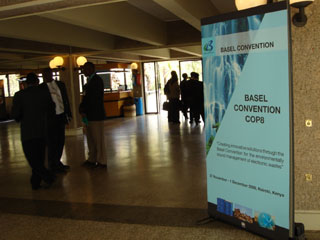

I have participated in the 8th Conference of the Parties of the Basel Convention, held in Nairobi, Kenya, from November 27 to December 1, as a member of the Japanese delegation and as an outgoing Compliance Committee member. As a delegate, I negotiated the legal issues, including the draft decision on the Draft Manual for Prosecutors relating to illegal Traffic, and on the issue of Interpretation of Article 17. paragraph 5 of the Basel Convention. On the latter issue, the EU and African Group submitted a draft decision which prejudges the outcome of the examination on the interpretation (or ambiguity) of Article 17 (5). Australia, Canada, Japan and NZ submitted counter-proposal, which sets a neutral process for the examination of the matter. The negotiation trying to bridge the gap was very difficult, as some saw this issue as a matter of political maneuver, whereas others saw this as a matter of legal principle. It was only late afternoon on Friday that a compromise draft decision was agreed among the core negotiators.
The main substantive negotiation on the issue of Article 17 paragraph 5 will be held at the next Open-ended Working Group.
Basel Convention Compliance Committee related matter:
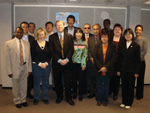
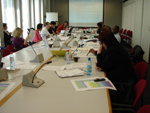

I had served as a member and the rapportuer of the Basel Convention Compliance Committee from 2002 to 2006. In this initial phase of the operation of the Committee, the members first clarified the internal rules and procedures of the Committee, based on my paper. From 2004, the Committee was mandated to examine “general issues of compliance” on reporting, focal points and national legislation. We were also able to publish a leaflet describing succinctly the procedure of the Mechanism. This work was based on the initial draft by the Secretariat with extensive revisions made by me. My work on this leaflet was possible with the funding from my school. As can be seen, the concrete outputs of the Committee heavily depend on the voluntary work of individual members. From this perspective, it was unfortunate that many members were substituted during these four years (members from Canada, China, Kenya, Mexico and Malaysia changed), where continuous and sustained work of members were vital for the Committee’s effectiveness.
It was also unfortunate that the Committee did not receive a Paragraph 9 specific submission. My expectation when I was elected 4 years ago was that the Committee would receive a specific submission and, as a precedent setting case, the examination of such case would be very important for the Committee. This opportunity was missed.









